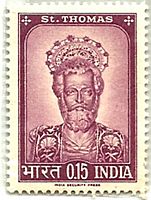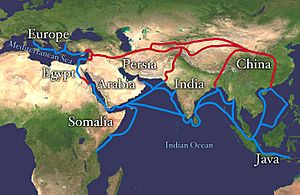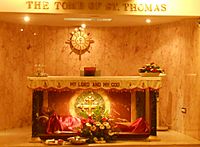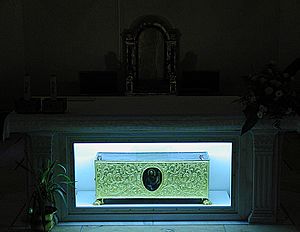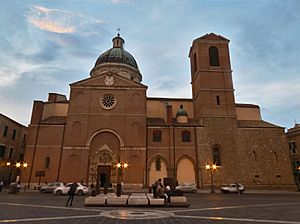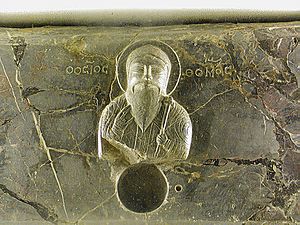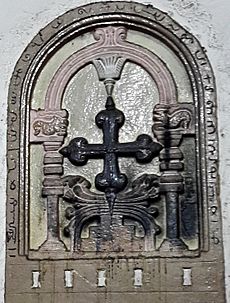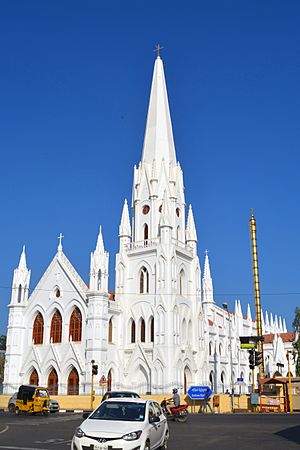Thomas the Apostle facts for kids
Quick facts for kids SaintThomas the Apostle |
|
|---|---|

St Thomas (c. 1611) by Peter Paul Rubens
|
|
| Apostle, Preacher, Martyr | |
| Born | 1st century AD Pansada, Galilee, Judea, Roman Empire |
| Died | AD 72 St. Thomas Mount, Mylapore, Chennai, Chola Empire |
| Venerated in | All Christian denominations that venerate saints, especially Saint Thomas Christians |
| Canonized | Pre-Congregation |
| Major shrine | St. Thomas Cathedral Basilica in Mylapore, Chennai, India Basilica of St. Thomas the Apostle in Ortona, Italy |
| Feast |
|
| Attributes | The Twin, placing his finger in the side of Christ, nelumbo nucifera, spear (means of his Christian martyrdom), square (his profession, a builder) |
| Patronage | Architects, For Christians in India (including Saint Thomas Christians and Archdiocese of Madras-Mylapore), Tamil Nadu, Sri Lanka and Pula (Croatia) |
Thomas the Apostle (Imperial Aramaic: 𐡀𐡌𐡅𐡕𐡌, Biblical Hebrew: תוֹמא הקדוש or תוֹמָא שליחא (Toma HaKadosh "Thomas the Holy" or Toma Shlikha "Thomas the Messenger/Apostle" in Hebrew-Aramaic), Classical Syriac: ܬܐܘܡܐ, Tʾōmā, meaning "twin"; Koinē Greek: Θωμᾶς), also known as Didymus (Greek: Δίδυμος Didymos, meaning "twin"), was one of the Twelve Apostles of Jesus. He is famous for being "Doubting Thomas" because he first doubted that Jesus had come back to life. However, when he saw Jesus' wounds from the crucifixion, he believed.

Many Christians in Kerala, India, called Saint Thomas Christians, believe that Saint Thomas traveled to India to share the Gospel. They say he arrived in Muziris (now in Kerala) in AD 52. In 1258, some of his relics (special objects connected to a saint) were moved to Ortona, Italy. Thomas is seen as the patron saint of India for Christians there. His feast day, July 3, is celebrated as Indian Christians' Day. The name Thomas is still very popular among these Christians in India.
Many churches in the Middle East and southern Asia also say that Apostle Thomas was the first to start their churches. This includes the Chaldean Catholic Church and the Assyrian Church of the East.
Contents
What did Thomas say in the Bible?
Thomas speaks a few times in the Gospel of John. Let's look at some of his famous lines.
"Let us also go, that we may die with him."
In John 11:16, Lazarus had just died. The other apostles were worried about going back to Judea. Thomas bravely said, "Let us also go, that we may die with him." This showed his loyalty to Jesus.
"Lord, we know not whither thou goest; and how can we know the way?"
In John 14:5, Jesus was explaining that he was going to prepare a place in heaven for his followers. Thomas asked, "Lord, we do not know where you are going. How can we know the way?" This question led Jesus to say, "I am the way, the truth, and the life."
"My Lord and my God!"
John 20:24–29 tells the story of "Doubting Thomas". When the other apostles said Jesus had risen from the dead, Thomas didn't believe them. He said, "Unless I see the nail marks in his hands and put my finger where the nails were, and put my hand into his side, I will not believe."
Later, Jesus appeared again and invited Thomas to touch his wounds. Thomas then believed and said, "My Lord and my God!" Jesus replied, "Because you have seen me, you have believed; blessed are those who have not seen and yet have believed."
What does the name Thomas mean?
The name Thomas comes from the Aramaic word Tʾōmā. This word means "twin." The Greek word for twin, Didymos, is also used for him in the New Testament.
Other names for Thomas
Some old writings, like the Gospel of Thomas, call him "Didymus, Judas Thomas." Early traditions from Syria also say his full name was Judas Thomas. Some people think he might be the same as Jude the Apostle. Others believe he was Jude, brother of Jesus.
The phrase "Doubting Thomas" is still used today. It describes someone who won't believe something without seeing it or experiencing it themselves. This comes from Thomas's story in the Gospel of John.
When are Thomas's feast days?
A feast day is a special day to remember a saint.
- The Latin Church (Roman Catholics) celebrates Saint Thomas on July 3.
- Some Anglicans and Traditional Catholics celebrate him on December 21.
- The Eastern Orthodox and Byzantine Catholic churches celebrate his feast day on October 6. They also have a special "Sunday of Thomas" after Easter.
- The Malankara Orthodox Church celebrates him on July 3, December 18, and December 21.
Where did Thomas travel?
His mission in India
Many Saint Thomas Christians in India believe that Apostle Thomas arrived in Muziris (now Cranganore) on the Kerala coast in AD 52. They believe he was killed in Mylapore, near Chennai, in AD 72. This port was later destroyed by a flood in 1341.
It is believed that Thomas started seven churches (Christian communities) in Kerala. These churches are in places like Kodungallur, Palayoor, and Kollam. He also baptized several families. Many families in India today say their Christian faith goes back to these early times.
An important writer named Ephrem the Syrian wrote in the 4th century that Thomas was killed in India. He also said that Thomas's remains were later moved to a city called Edessa.
Old records from Eusebius say that Thomas and another apostle, Bartholomew, went to Parthia and northwest India. The Didascalia, a Christian text from the 3rd century, says that Thomas brought Christian teachings to India and the lands around it.
It is believed that Thomas left northwest India because of danger. He traveled by ship to the Malabar Coast, possibly stopping in Arabia and Socotra. He landed at the port of Muziris around AD 50. From there, he preached the gospel along the Malabar coast. He started churches mainly along the Periyar River and the coast, where there were Jewish communities. Thomas also appointed teachers and leaders for these early churches.
How did Thomas die?
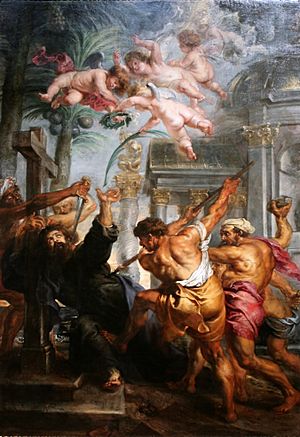
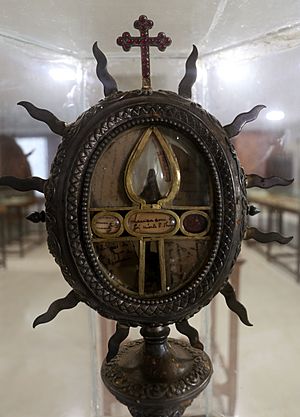
According to Christian tradition in Syria, Thomas was killed with a spear. This happened at St. Thomas Mount in Chennai on July 3, AD 72. His body was buried in Mylapore. The Latin Church tradition says he died on December 21.
Ephrem the Syrian wrote that Thomas was killed in India and his relics were taken to Edessa. This is the earliest known record of his death.
In the 16th century, explorer Duarte Barbosa wrote that a Muslim person looked after Thomas's tomb in Mylapore. The St. Thomas Cathedral Basilica, Chennai, which is now at the tomb, was first built by the Portuguese in the 16th century. It was rebuilt by the British in the 19th century.
Did Thomas visit China?
Some traditions among Saint Thomas Christians in India say that Thomas also visited China. For example, a Malayalam song called Thomas Ramban Pattu from the 17th century mentions this. These stories say Thomas went to India, then to China, and then back to India, where he died.
Other old writings, like the "Law of Christianity" by Ibn al-Ṭayyib (who died in 1043), also mention Thomas going to China. This idea might have started around the 3rd century.
Did Thomas travel to Indonesia or Paraguay?
Some people, like Kurt E. Koch, believe Thomas might have traveled to Indonesia with Indian traders.
There is also an old oral tradition among the Guaraní tribes in Paraguay. They claim that Apostle Thomas visited Paraguay and preached to them. In the 19th century, some miners in Paraguay found stones with old letters carved into them. Experts thought they looked like Hebrew symbols. People believed these letters were made by Thomas the Apostle.
Where are Thomas's relics?
Mylapore
Traditional stories say that Apostle Thomas preached in Kerala and other parts of Southern India. A few of his relics are still kept at San Thome Basilica in Mylapore, Chennai, India. The famous traveler Marco Polo is said to have visited Southern India in 1292.
Edessa
According to tradition, in AD 232, most of Thomas's relics were sent from Mylapore to the city of Edessa in Mesopotamia. This is when his Syriac Acts (stories about his life) were written.
In the 4th century, a special building was built over his burial place in Edessa. This brought many pilgrims (religious travelers) to the city. In 394, his bones were moved to a church inside Edessa.
Chios and Ortona
The relics of Saint Thomas stayed in Edessa until they were moved to the island of Chios in 1258. Some of these relics were later taken to the West and are now in the Cathedral of St. Thomas the Apostle in Ortona, Italy. However, Thomas's skull is said to be in the Monastery of Saint John the Theologian on the Greek island of Patmos.
The story says that in 1258, three ships from Ortona arrived at Chios. The general, Leone Acciaiuoli, found a chapel with the body of Saint Thomas. He took a bone from the tombstone. The next night, he and a friend secretly took the rest of the relics and the tombstone. They brought them back to Ortona on September 6, 1258.
Since then, the body of the apostle and the tombstone have been kept in the crypt of the Basilica in Ortona. The relics survived attacks in 1566 and the destruction during the battle of Ortona in 1943. The monks hid them inside the bell tower, which was the only part of the church that survived.
The tombstone of Thomas, brought to Ortona from Chios, is in the crypt of St. Thomas Basilica. It has Greek letters carved on it that say 'osios thomas', meaning Saint Thomas. This carving is believed to be from the 3rd–5th century.
Iraq
Some of Saint Thomas's finger bones were found during repair work at the Church of Saint Thomas in Mosul, Iraq, in 1964. They were kept there until 2014, when they were moved to the Monastery of Saint Matthew for safety.
What did early Christian writers say about Thomas?
Origen
Origen, a Christian philosopher from the 3rd century, said that Thomas was given the region of Parthia to preach in.
Eusebius
Eusebius of Caesarea, a historian, also wrote that Thomas was sent to Parthia. He also mentioned that "Judas, who is also called Thomas" played a role in the story of King Abgar of Edessa.
Ephrem the Syrian
Ephrem the Syrian, a writer from the 4th century, wrote many hymns about Saint Thomas. In one hymn, the devil says of Thomas, "the Apostle I slew in India." This shows that people believed Thomas preached and died in India.
Gregory of Nazianzus
Gregory of Nazianzus, a bishop from the 4th century, wrote about where each apostle went. He said, "Peter indeed may have belonged to Judea, but what had Paul in common with the gentiles, Luke with Achaia, Andrew with Epirus, John with Ephesus, Thomas with India, Mark with Italy?" This also supports the idea of Thomas's mission in India.
Ambrose of Milan
Ambrose of Milan, another important bishop from the 4th century, also mentioned Thomas's travels. He said, "Even those Kingdoms which were shut out by rugged mountains became accessible to them, as India to Thomas, Persia to Matthew..."
Gregory of Tours
Gregory of Tours, a historian who died in 594, wrote that Thomas suffered (died) in India. He also said that Thomas's holy remains were later moved to Edessa. He mentioned a large church and monastery in India where Thomas first rested.
What writings are linked to Thomas?
In the early centuries of Christianity, several writings were connected to Thomas.
- The Infancy Gospel of Thomas was likely written in the 2nd century. It tells stories about Jesus's childhood. For example, it tells the famous story of Jesus making twelve sparrows out of clay on the Sabbath, and they flew away.
- The Gospel of Thomas is another well-known writing. It is a collection of sayings, or quotes, believed to be from Jesus. This work was found in 1945 in Egypt.
What is the Saint Thomas Cross?
The Saint Thomas Cross is a special type of cross. It is also called the Nasrani Menorah or Persian Cross. These crosses are thought to be from the 6th century and are found in churches in Kerala, Mylapore, and Goa.
There are different ways to understand the meaning of the Saint Thomas Cross.
- Some believe its design comes from the Jewish menorah, an ancient Jewish symbol.
- Others say the cross, without a figure of Jesus and with flowery arms, represents the joy of Jesus's resurrection. The Holy Spirit is shown at the top.
- The lotus flower at the bottom might symbolize Buddhism, showing that Christianity was established in a land where Buddhism was present.
- The three steps below the cross represent Calvary, the hill where Jesus was crucified. The lines flowing from the cross are seen as channels of God's grace.
Thomas in Islam
The Qur’an (the holy book of Islam) talks about the disciples of Jesus. It does not give their names or detailed stories. However, Muslim scholars generally agree with the New Testament list of disciples, which includes Thomas.
Major shrine
Santhome Church
Santhome Church is believed to be built over the tomb of St. Thomas in Chennai, India. It was built by Portuguese missionaries in 1523. It is a very important place for Christians and a major shrine dedicated to St. Thomas.
See also
 In Spanish: Tomás el Apóstol para niños
In Spanish: Tomás el Apóstol para niños
- Book of Thomas the Contender
- Syro-Malabar Catholic Church
- Syro-Malankara Catholic Church
- Syriac Orthodox Church
- Jacobite Syrian Christian Church
- Malankara Orthodox Syrian Church
- Gospel of Barnabas
- List of patriarchs of the Church of the East
- Mar Thoma Syrian Church
- Quetzalcoatl, an Aztec god that was thought a reflection of Thomas by some Catholic missionaries
- Saint Thomas of Mylapur
- São Tomé
- St. Thomas' Church (disambiguation) – for a listing of all churches and chapels named in his honour


